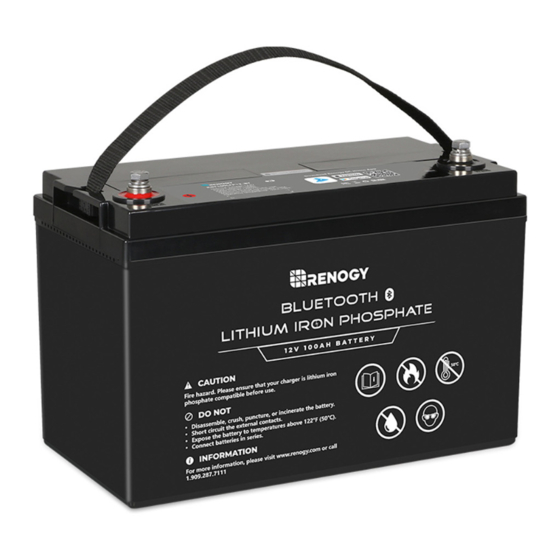
Table of Contents
Advertisement
Quick Links
Advertisement
Table of Contents

Summary of Contents for Renogy RBT100LFP12-BT-US
- Page 1 BATTERY BLUETOOTH LITHIUM IRON PHOSPHATE 12V 100Ah Version 1.1...
- Page 2 Important Safety Instructions Please save these instructions. This manual contains important installation, operation, and maintenance instructions for the Lithium Iron Phosphate Battery w/ Bluetooth. Please observe these instructions and keep them located near the battery for further reference. The following symbols are used throughout the manual to indicate potentially dangerous conditions or important safety information.
- Page 3 ● DO NOT place tools on top of the battery. ● Please keep the battery out of the reach of young children. ● Please wear proper protective equipment when working on the battery. ● Please use insulated tools when working on the battery. ●...
-
Page 4: Table Of Contents
Tabel of Contents General Information ����������������������������������������������������������������������������������������������04 Key Features ����������������������������������������������������������������������������������������������04 Product Overview �������������������������������������������������������������������������������������������������05 Identification of Parts ������������������������������������������������������������������������������������05 Dimensions ������������������������������������������������������������������������������������������������05 Additional Components ���������������������������������������������������������������������������������06 Preparation ���������������������������������������������������������������������������������������������������������06 Battery Installation ������������������������������������������������������������������������������������������������06 Inspection ��������������������������������������������������������������������������������������������������06 Sizing Cables ����������������������������������������������������������������������������������������������07 Connecting Batteries in Bank �������������������������������������������������������������������������07 Securing Cable Connections ��������������������������������������������������������������������������08 Installation Environment ��������������������������������������������������������������������������������09 Battery Operation �������������������������������������������������������������������������������������������������09 Activating Battery �����������������������������������������������������������������������������������������09... -
Page 5: General Information
General Information The Renogy Lithium Iron Phosphate Battery w/ Bluetooth is designed for the drop-in replace- ment of deep-cycle lead-acid batteries with its standard BCI group size. Weighing only half of the lead-acid counterparts, the battery can be safely discharged to 100% DOD (Depth of Discharge), delivering twice the energy. -
Page 6: Product Overview
Product Overview Identification of Parts ① Positive Terminal ② Negative Terminal ③ Lifting Strap ① ③ ② Dimensions [10.43in] 265mm [12.99in] 330mm... -
Page 7: Additional Components
Additional Components ● Long Terminal Bolts (2) The Long Terminal Bolts (M8x1.25x20mm) are used to secure multiple cable lugs on a single battery terminal Preparation Before the installation and operation of the battery, it is recommended to have the following equipment or tools available: ●... -
Page 8: Sizing Cables
rosion, and dry. If any problems are detected with the battery, please contact us for assistance. Refer to the last page of the manual for contact information. Sizing Cables Battery cables (sold separately) should be appropriately sized to handle the expected load. Please refer to the following table for the ampacities of copper cables with different gauge sizes. -
Page 9: Securing Cable Connections
To connect multiple batteries in parallel, first connect the Positive Terminals of the batteries to each other. Then, connect the Negative Terminals of the batteries to each other. Finally, con- nect the Positive Terminal of the first battery and the Negative Terminal of the last battery to the system. -
Page 10: Installation Environment
Installation Environment The battery should be installed in a clean, cool, and dry place, keeping water, oil, and dirt away from the battery. The accumulation of these materials on the battery can cause current leakage, resulting in self-discharge and a possible short-circuit. Sufficient air flow must be provided to prevent excessive heat build-up and to minimize temperature variation between the paralleled connected batteries. -
Page 11: Discharging Battery
until the battery voltage reaches 14.4V. Then, the battery is charged at a constant voltage of 14.4V while tapering the charge current. The standard charging process is considered com- plete when the charge current is less than 5A. However, leaving the battery on float will con- tinue to balance the battery cells and will not damage the battery. -
Page 12: Checking Voltage
● Clean the top of the battery and terminals with a damp cloth or non-metallic brush. A house- hold cleaner may be used if the battery is extremely dirty. ● Dry the battery with a clean cloth and keep the area around the battery clean and dry. ●... -
Page 13: Battery Management System
Battery Management System Warning and Protection The battery contains a battery management system (BMS) that warns the user and protects the battery from overvoltage, undervoltage, overcurrent, short circuit, high temperature, and low temperature. Please refer to the following table for the triggering and recovery condition of each warning and protection. -
Page 14: Battery Cell Balancing
Battery Operation Status Condition Battery Temperature≤32°F (0°C) Trigger Charge Low Temperature Protection Battery Temperature≥41°F (5°C) Recover Battery Temperature≤14°F (-10°C) Trigger Warning Battery Temperature≥23°F (-5°C) Recover Discharge Low Temperature Battery Temperature≤-4°F (-20°C) Trigger Protection Battery Temperature≥1.4°F (-17°C) Recover Charge Current≥60A Trigger Warning Charge Current≤55A Recover... -
Page 15: Troubleshooting
battery cell group will be closed to shunt the charge current around the highest-voltage battery cell group through the bypass resistor until the voltage difference drops below the set value. To avoid excessive energy loss, the battery cell balancing is only performed during the charging process. -
Page 16: Specifications
Specifications General Battery Cell Type Lithium Iron Phosphate Rated Capacity (0.3C, 25°C) 100Ah Nominal Voltage 12.8V Voltage Range 10V~14.8V Cycle Life (0.5C, 25°C) 2000 Cycles (80% DOD) 12.99 x 6.77 x 8.43 inch Dimension 330 x 172 x 214 mm Weight 28.7 lbs.











Need help?
Do you have a question about the RBT100LFP12-BT-US and is the answer not in the manual?
Questions and answers